Simple analog projection clock
Very simple projection clock with a warm tube analog dial gauge in the projection. Not a single lens!

')
First we need a quartz watch. Because a mirror will be used to form an image, then the clock must go in the opposite direction to get the current time. I wrote about such watches. Take a watch from the IKEA store:

Take out of the case, remove the arrows:
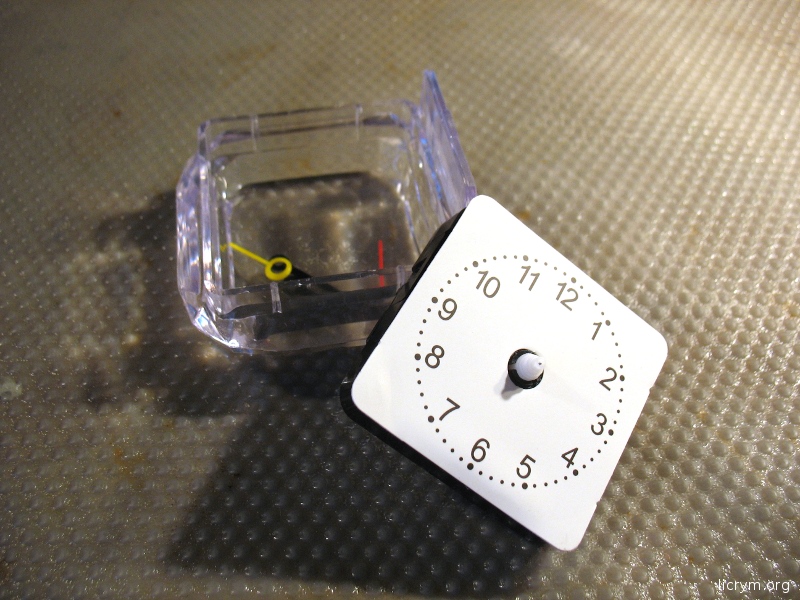
We open the case (it snaps into place, turn the ringer switch to the left). To change the direction of rotation, turn the coil core. The direction of rotation is determined by the small asymmetry of the core, therefore changing the polarity of the coil does not change the direction of rotation.
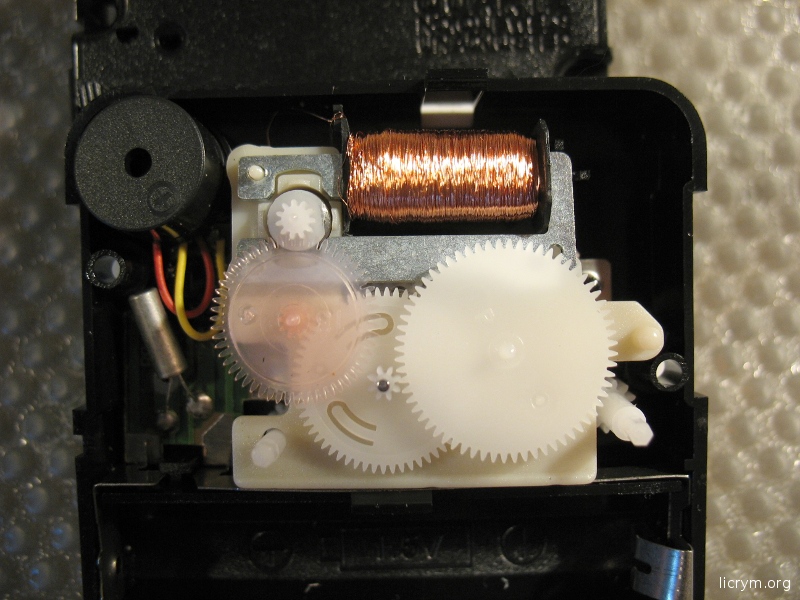
The next stage is the creation of a mirror dial. The cheapest and angry option is to use a pancake from a dead hard drive - it is flat and has a hole in the center. Labels can be applied to it with a permanent marker. But in this case it is necessary to lengthen the arrows. (Who will make a watch with a mirror of pancake - please add them to the article.) In my design I used a regular glass mirror:
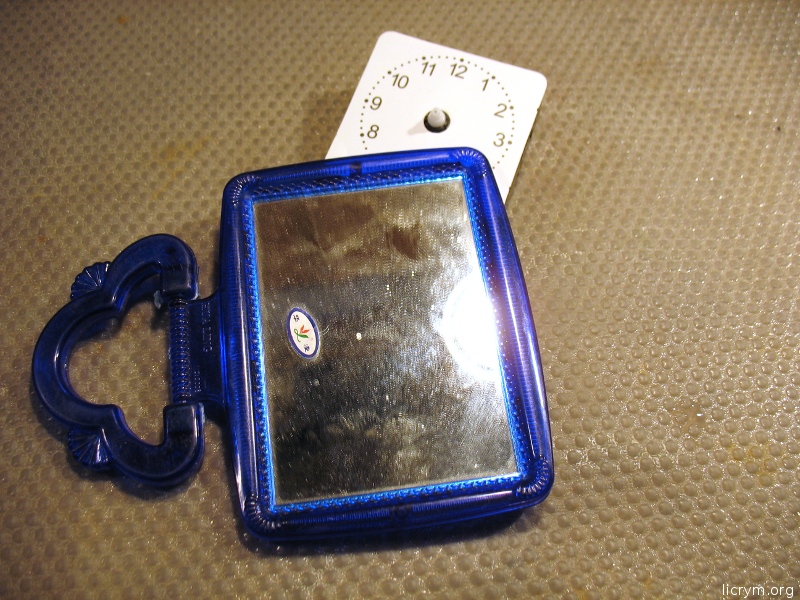
Mark up the mirror and a diamond bit on the glass we drill a hole. To cool, add water, the maximum speed, the effort is minimal, otherwise the glass will burst. With proper accuracy can be drilled with a drill on the glass.

Hourly risks can be drawn with a marker. But then when rubbing the glass from dust with solvents, they will be erased. You can do otherwise - with a sharp object on the back side of the mirror, scratch the reflective layer and blacken:

As a result, the dial is obtained:
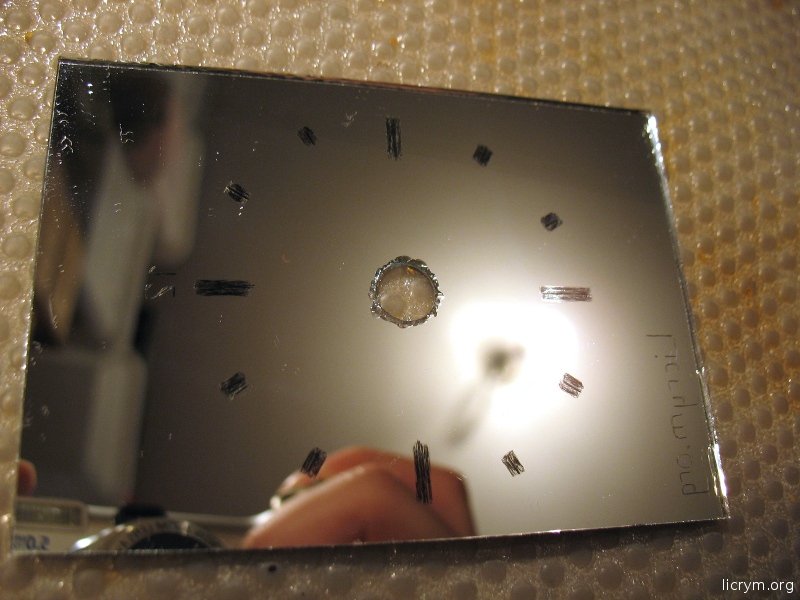
An LED is used as a light source. An ideal projection is obtained when illuminating with parallel rays. In this case, SMD white LED is used. Light-emitting diodes in a 5mm housing with an integrated lens gives worse definition results.
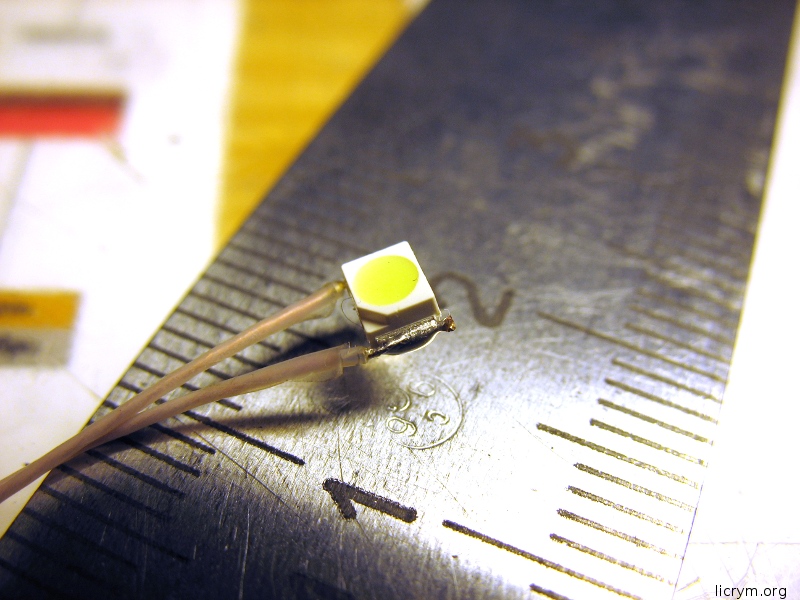
Create a pedestal. The LED is powered by a 12V power supply through a 470 ohm ballast resistor. Ideally, of course, it would be ideal to use a current generator, like the NSI45020, but we have an emphasis on simplicity. The LED is attached to a flexible wire, which is molded in place.
(calculation of the resistor: the current through the standard LED 20 mA = 0.02 A. The voltage drop on the LED depends on the color. On the LED, which is in the article, drops 3.11 V. The power supply unit is 12 V. So 12-3.11 = should 8.89V at 0.02 A. And here the law of ohm is R = U / I = 8.89 / 0.02 = 444.5 Ohm.

Fasten the watch itself:
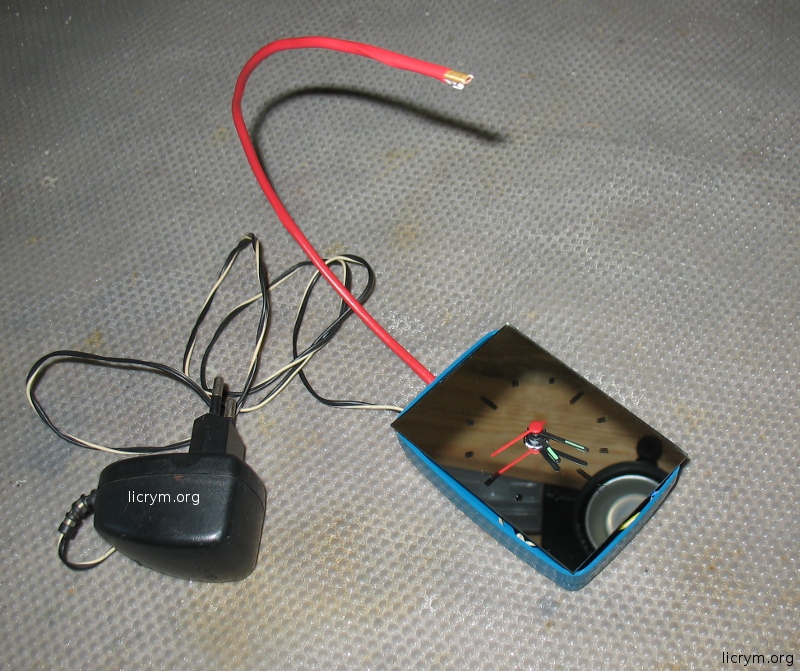
The angle of incidence is equal to the angle of reflection. We remember this and bending the antenna with the LED, we select the desired projection place on the ceiling. The size of the projection is governed by the distance between the mirror and the LED. Direction - deviation from the center. To cut off the light that illuminates the space around the clock, you can add a visor to the LED. Without a visor, the clock will also be a nightlight.

We look at the projection. It turns out slightly fuzzy, but the time is perfectly read:

At large angles, the image of the arrow begins to double (reflection from the glass surface + reflection from the metallization). When using pancakes from a hard disk, this effect should not be.
As usual, this is the only repost of articles on the Internet related to the weakness and unreliability of the portal server.

')
First we need a quartz watch. Because a mirror will be used to form an image, then the clock must go in the opposite direction to get the current time. I wrote about such watches. Take a watch from the IKEA store:

Take out of the case, remove the arrows:

We open the case (it snaps into place, turn the ringer switch to the left). To change the direction of rotation, turn the coil core. The direction of rotation is determined by the small asymmetry of the core, therefore changing the polarity of the coil does not change the direction of rotation.

The next stage is the creation of a mirror dial. The cheapest and angry option is to use a pancake from a dead hard drive - it is flat and has a hole in the center. Labels can be applied to it with a permanent marker. But in this case it is necessary to lengthen the arrows. (Who will make a watch with a mirror of pancake - please add them to the article.) In my design I used a regular glass mirror:

Mark up the mirror and a diamond bit on the glass we drill a hole. To cool, add water, the maximum speed, the effort is minimal, otherwise the glass will burst. With proper accuracy can be drilled with a drill on the glass.

Hourly risks can be drawn with a marker. But then when rubbing the glass from dust with solvents, they will be erased. You can do otherwise - with a sharp object on the back side of the mirror, scratch the reflective layer and blacken:

As a result, the dial is obtained:

An LED is used as a light source. An ideal projection is obtained when illuminating with parallel rays. In this case, SMD white LED is used. Light-emitting diodes in a 5mm housing with an integrated lens gives worse definition results.

Create a pedestal. The LED is powered by a 12V power supply through a 470 ohm ballast resistor. Ideally, of course, it would be ideal to use a current generator, like the NSI45020, but we have an emphasis on simplicity. The LED is attached to a flexible wire, which is molded in place.
(calculation of the resistor: the current through the standard LED 20 mA = 0.02 A. The voltage drop on the LED depends on the color. On the LED, which is in the article, drops 3.11 V. The power supply unit is 12 V. So 12-3.11 = should 8.89V at 0.02 A. And here the law of ohm is R = U / I = 8.89 / 0.02 = 444.5 Ohm.

Fasten the watch itself:

The angle of incidence is equal to the angle of reflection. We remember this and bending the antenna with the LED, we select the desired projection place on the ceiling. The size of the projection is governed by the distance between the mirror and the LED. Direction - deviation from the center. To cut off the light that illuminates the space around the clock, you can add a visor to the LED. Without a visor, the clock will also be a nightlight.

We look at the projection. It turns out slightly fuzzy, but the time is perfectly read:

At large angles, the image of the arrow begins to double (reflection from the glass surface + reflection from the metallization). When using pancakes from a hard disk, this effect should not be.
As usual, this is the only repost of articles on the Internet related to the weakness and unreliability of the portal server.
Source: https://habr.com/ru/post/117653/
All Articles